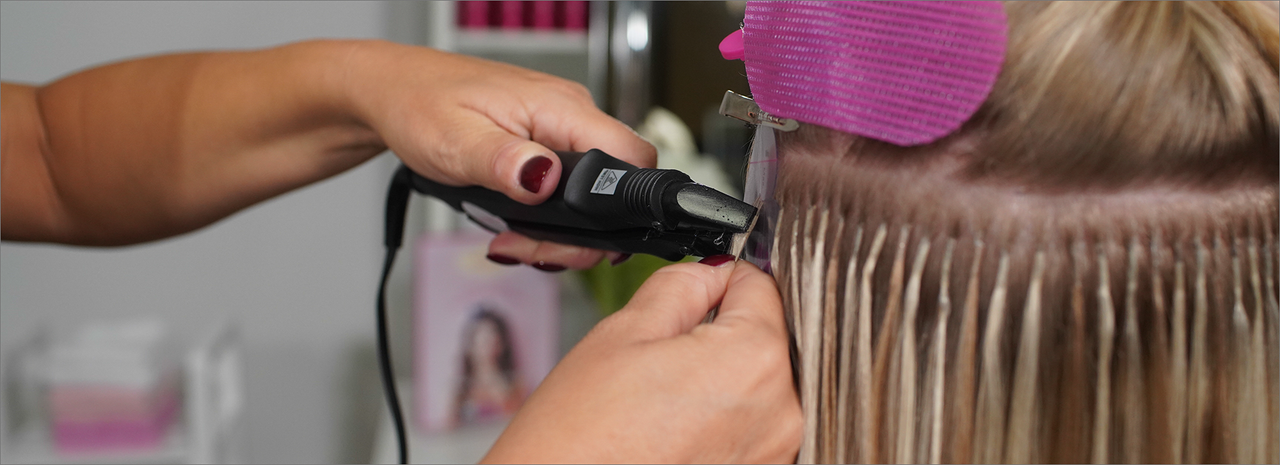Babe’s hair extension rules exist for a reason. They help to ensure best practices, keep hair extensions in tip-top shape, and preserve the client’s hair health throughout the process. They make your job as a stylist easier by giving you clear performance guidelines and eliminating guesswork! But, as with many rules, there are exceptions worth noting. Here are 3 of Babe’s most fundamental rules and their exceptions--decoded.
Don’t install on hair shorter than the occipital. This is the golden consultation rule. If your client’s hair is shorter than the occipital bone (jaw-length or shorter), you’re not supposed to install extensions on them with the intention of adding length. This rule is designed to prevent bad hair extension jobs, as it’s notoriously difficult to blend hair extensions into super-short hair. That being said, there are some things to keep in mind:
- You’re still clear to install hair extensions for the purpose of adding volume. Such extensions will not need to be disguised into the hair, as they will not protrude beyond the client’s base hair length. In these cases, the client’s hair need only be long enough to hide the attachments of the hair extensions.
- You can still install hair extensions for length, but the target length should be no more than twice the length of the client’s own hair. The whole “don’t install hair extensions on hair shorter than the occipital” rule applies mainly to clients looking to go from short hair to long hair--a transition that can’t really be disguised, and so shouldn’t be undertaken at all. If the client is only looking to add a few inches of length, though, blending that work would be totally feasible. So, to rephrase the original rule, stay within twice the length of the client’s own hair. If your client has a short bob just barely grazing her jawline, don’t install extensions that extend below her shoulders.
Stay within two shades of the original color. We consistently recommend that you try to match your client’s hair color to one of our pre-colored hair extension shades, but we acknowledge that that’s not always possible. Hair comes in a wide range of colors, and some clients’ hair will inevitably fall in-between our existing shades. So we implemented a few coloring rules for stylists: use demi- or semi- permanent dye, stay within two shades of the original color, and never lift (or lighten). These rules serve to preserve hair extension quality in the face of chemical coloring treatments, as Babe extensions have already been color-treated. While we maintain that demi- and semi- permanent dye is preferable, and that hair should absolutely not be lightened, we have to address the two-shade rule, as there is one commonly-used practice that goes against it:
- Platinum-colored extensions--our lightest available hair extension shades--may reasonably be colored to any level and tone that the stylist and client desire. These extensions don’t require a lot of dye to achieve the end result, as they’re more porous than our other extension colors and contain the least amount of pigment. We actually advise stylists undertaking more experimental hair coloring jobs--say pastel colors, ombre, emerald tones, etc.--to work with our #60, #600, or #1001 shades, as they produce the most accurate and saturated colors.
Don’t reuse hair more than 3 times. Babe hair extensions experience some wear-and-tear over time, especially at the tips (bond area) and ends. Therefore, we advise that stylists reuse the hair no more than 3 times, pegging the total lifespan of our professional hair at roughly 4-6 months. This rule serves to prevent negative hair extension experiences, as old extension tips are more likely to slip from the client’s hair, and old extension ends are more likely to mat and break. But, as you might expect, this rule could do with some additional decoding:
- The specificity of “3 times” is actually just an estimate based off of our experience working with hair extensions. What’s more important is the quality of the hair. Though rare, it is possible that extensions are in good enough shape to be reused beyond 3 times, particularly when the client is very vigilant about hair extension care. The stylist should ultimately use their professional discretion in these cases.
- When we say “reuse” here, what we really mean is “re-install.” Hair extensions should, in general, not be installed a 4th time, but they can absolutely be reused in other ways. If your client would like to keep the old extensions (seeing as they purchased them), old hair extensions can be remade into hair accessories like braid headbands, bun fillers, and the like. If they choose to dispose of the old extensions, keep them on hand in your salon as test strands for coloring projects, or as a visual aid for educational purposes. The options go on and on.
Have you ever exploited the exception to a hair extension rule? What did you notice? Share your experiences and questions in the comments below!

